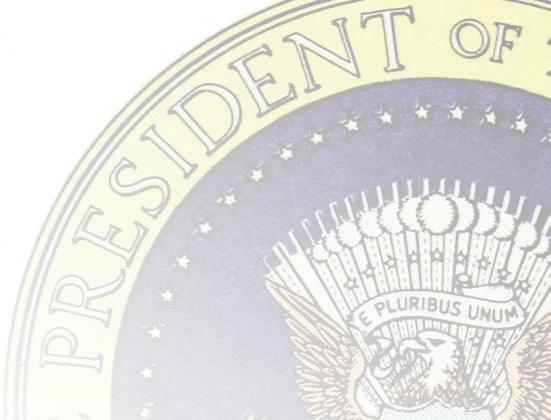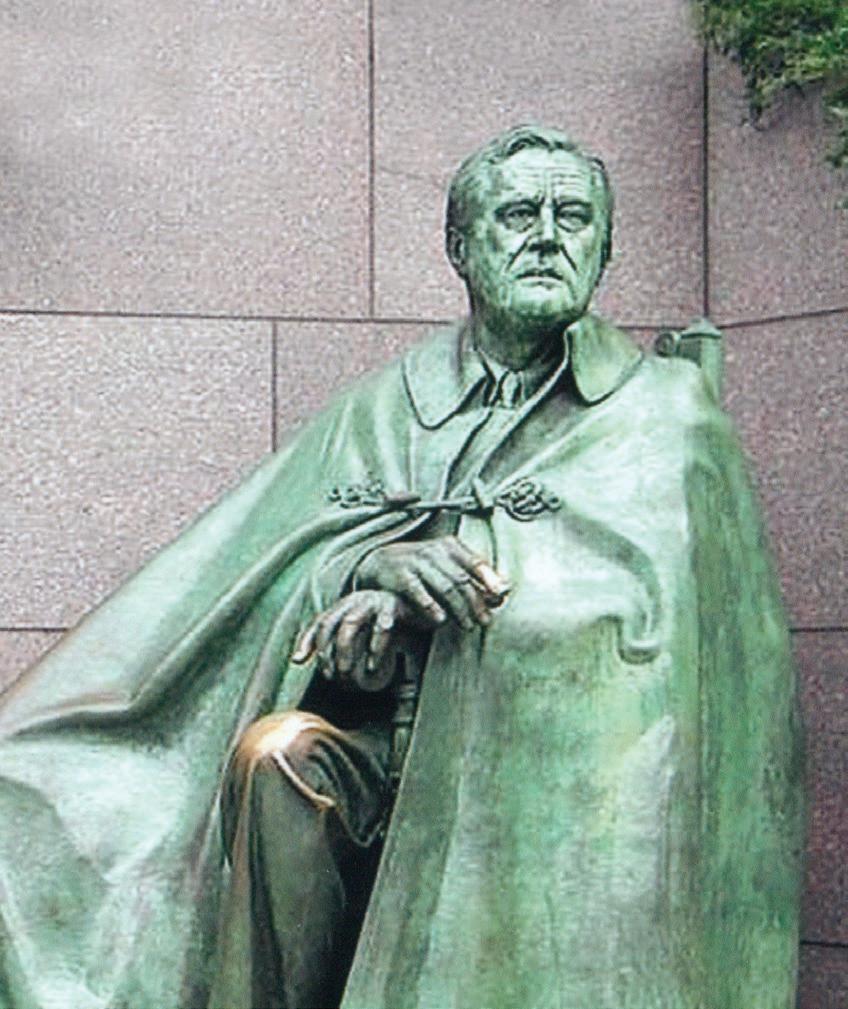
9 minute read
DC MONUMENTS
THE DWIGHT D. EISENHOWER MEMORIAL

Advertisement
NEW IN 2020

Commissioned by Congress in 1999, the Dwight D. Eisenhower Memorial honors the legacy of the World War II Supreme Allied Commander and the Nation's 34th President.
Wh� wa� ��?
As Commander of the Allied Expeditionary Force in World War II, Eisenhower led the invasion of Normandy, a dramatic turning point in the war. He served two terms as President of the United States during a pivotal time in history.
His post-war leadership transformed America through commitment to education, transportation and exploration. His foreign policy ultimately led to the collapse of Soviet domination of eastern Europe.

World-renowned architect Frank Gehry's design is a combination of grand architectural elements, sculpture and combination of grand architectural elements, sculpture and green space, which highlights Eisenhower from his humble green space, which highlights Eisenhower from his humble childhood in America's heartland, to his decisive role as childhood in America's heartland, to his decisive role as Supreme Commander of the Allied Expeditionary Force in Supreme Commander of the Allied Expeditionary Force in World War II and his two terms as President. World War II and his two terms as President.


The Memorial features three bronze sculptures of Eisenhower by sculptor Sergey Eylanbekov, stone bas relief images and inscription panels with words from notable Eisenhower addresses.

Photo Credit: ©Evelyn Hockstein for The Washington Post
W���� i� i�?
540 Independence Ave., SW The Memorial is located in a newly created, four-acre public park adjacent to the National Mall, across the street from the Smithsonian National Air & Space Museum. Framing the entire park and Memorial is a first-of-its-kind stainless steel woven tapestry by artist Tomas Osinski, which depicts the cliffs at Pointe du Hoc on the Normandy coastline in peacetime.
7th Street SW
National Mall
Constitution Ave. NE 4th Street SW 3th Street SW
U.S. Capitol Building
Independence Ave. SW
Dwight D. Eisenhower Memorial
NOW take our advice on this… While artistic and unique during the day, go at night when the lights are on. It is absolutely majestic!
Photo Credit: Nicolas Raymond via Flickr

World War II Memorial
The WWII Memorial honors the 16 million who served in the armed forces of the U.S., the more than 400,000 who died, and all who supported the war effort from home. Symbolic of the defining event of the 20th Century, the memorial is a monument to the spirit, sacrifice, and commitment of the American people.
The memorial is divided into two sides, representing the Atlantic and Pacific fronts, and 56 pillars. Each pillar has two wreaths, one inside and one outside. One wreath consists of oak leaves, representing industrial might. The other consists of wheat, representing the agricultural might of the U.S. From the steps of the Lincoln Memorial the World War II Memorial is almost invisible. This is not by accident. The designers wanted to preserve the picturesque view from the far end of the National Mall.
The 4,048 Gold Stars on the Freedom Wall honors the 416,800 American servicemen who died in uniform during WWII (each star represeting 100 service members).
Look for “Kilroy” hiding on the outside of the memorial on the side closest to Lincoln. Kilroy was a symbol of American Serviceman, and writing “Kilroy was here” was a claim of victory.
Located in between the Washington Monument and Lincoln Memorial on the National Mall. Open 24 hours. Metro Station: Smithsonian. The best photos of the Lincoln Memorial can be taken here.


Korean War Veterans Memorial
Built in 1995, this memorial pays tribute to the soldiers who fought in the Korean War (1950-1953). The platoon on patrol is dressed in full combat gear, dispersed among strips of granite and juniper bushes, which represent the rugged terrain of Korea.
The Mural Wall is in the form of a triangle intersecting a circle, and shows photos of the land, sea, and air troops. The Pool of Remembrance lists the killed, wounded, missing in action, and prisoners of war. In the south side of the memorial, there are three bushes of the Rose of Sharon hibiscus plant, South Korea's national flower.
These memorials are located between the Lincoln and WWII memorials on the National Mall. NOW recommends viewing these memorials on the same trip to the World War II Memorial.
Vietnam Veterans Memorial
Built in 1982, this memorial honors the men and women who served in the controversial Vietnam War (1955-1975) and chronologically lists the names of 58,318 Americans who gave their lives in service to their country. The memorial includes the Vietnam Veterans Memorial “Wall," the “Three Servicemen Statue," and the “Vietnam Women's Memorial."
A common ritual is for visitors to take a piece of paper and place it over a name on the wall and rub a wax crayon or graphite pencil over it as a memento. Many who visit leave behind military dog tags, flowers, war medals, photographs, and even favorite toys in memoriam to those that have served.
Jeff erson Memorial

The Jefferson Memorial was built to honor the 3rd President of the United States and Founding Father, Thomas Jefferson. He was a Democratic- Republican who thought the national government should have a limited role in citizens’ lives. During his two terms in office (1801-1809), the U.S. purchased the Louisiana Territory and Lewis and Clark explored the vast new acquisition.
Although Jefferson promoted individual liberty, he was also a slave owner. After leaving office, he retired to his Virginia plantation, Monticello, and helped found the University of Virginia. Construction commenced in 1938 amid significant opposition–many Washingtonians opposed the site because it did not align with L'Enfant's original plan for the city; and many well-established elm and cherry trees, including rare stock donated by Japan in 1912, were targeted for removal under the memorial's original plan. Some opposition included protestors chaining themselves to cherry trees.
The protests ultimately helped limit the projected footprint of the new memorial, so that it would peacefully co-exist with the spring-blooming cherry orchard flanking and abutting it.
Located at the south end of the tidal basin. Open 24 hours a day. Metro Stations: Foggy Bottom, Smithsonian. NOW recommends visiting the two memorials on the opposite page during the same trip to the Jefferson Memorial, walking around the Tidal Basin.


Martin Luther King, Jr. Memorial Franklin Delano Roosevelt Memorial
Dr. Martin Luther King, Jr. was a Baptist minister and social activist who became a notable figure during the U.S. civil rights movement from the mid-1950s until he was assassinated in 1968. He played a pivotal role in ending the legal segregation of African American citizens, and implemented a non-violent philosophy while striving for freedom, justice, and equality. He is famously known for his iconic “I Have a Dream" speech that he delivered on the steps of the Lincoln Memorial during the March on Washington in 1963. Known simply as FDR, Franklin Delano Roosevelt guided America through the Great Depression and World War II as our nation's 32nd president.
It traces 12 years of U.S. history through a sequence of four outdoor rooms and gardens (one for each of FDR's terms of office), animated by water, stone, and sculpture. As one moves from room to room, the waterfalls become larger and more complex, reflecting the increasing complexity of a presidency marked by the vast upheavals of economic depression and world war.
These memorials are located between the Lincoln and Jefferson Memorials, along the tidal basin. Metro Stations: Foggy Bottom, Smithsonian
Lincoln Memorial

The Lincoln Memorial was built to honor the 16th President of the United States, Abraham Lincoln. The memorial has been the site of many famous speeches, including Martin Luther King Jr.’s “I Have a Dream” speech, and is visited by more than seven million annually. 36 states border the top of the exterior marble (the number of states at the time of Lincoln's death).
When viewers bask in the 99-foot-tall, 202-foot-wide Lincoln Memorial, they’re really only seeing a little more than half of the construction. The piece’s foundation, which extends 66 feet into the earth at its deepest point, supports the weight of the marble structure. Lincoln Rumors – what do you believe?:
• Legend has it that Lincoln is shown using sign language to represent his initials, with his left hand shaped to form an “A” and his right hand to form an “L“. The National Park Service denies this theory, calling them urban legends. However, there are a lot of facts to back this claim up! Like this one...
• ...Lincoln himself was particularly invested in the cause of furthering the study of sign language and had authorized the creation and signed the charter of Gallaudet University, the school for the deaf, also in DC. Daniel Chester French, designer of Lincoln's Statue, also designed the school as well.
• Some claim that the face of General Robert E. Lee was carved onto the back of Lincoln’s head, and looks back across the Potomac toward his former home, Arlington House, now within the bounds of Arlington National Cemetery. If you see people trying to get a good look at the back of his head while visiting the Memorial, now you know why!
Located at the west end of the National Mall. Open 24 hours a day. The early evening and morning hours are beautiful and tranquil times to visit. Metro Stations: Foggy Bottom and Smithsonian

Arlington National Cemetery
Since 1864, Arlington National Cemetery has been a national shrine to those who have honorably served our Nation during times of war – including every military conflict in American history – and during times of peace. The cemetery is the final resting place for more than 400,000 active duty service members, veterans and their families. The original cemetery was 200 acres, and has since grown to 639 acres. The grounds honor those who have served our nation and provide a sense of beauty and peace for our guests. Rolling green hills are dotted with trees that are hundreds of years in age, complementing the gardens found throughout the property. Arlington officially became a national cemetery on June 15, 1864, by order of Secretary of War Edwin Stanton. Arlington became a segregated cemetery, just like all national cemeteries at the time, and remained segregated by race and rank until 1948, when President Harry S. Truman desegregated the military.
Guests are encouraged to download the app ANC Explorer, to help navigate gravesites and places of interest, obtain walking directions and photos, and find events. The app is available on the cemetery’s website, on-site kiosks or through online app stores.
Located across the Potomac River in Virginia. Hours: 8am-5pm Metro Station: Arlington National Cemetery Free admission. Tram Tours Available.










